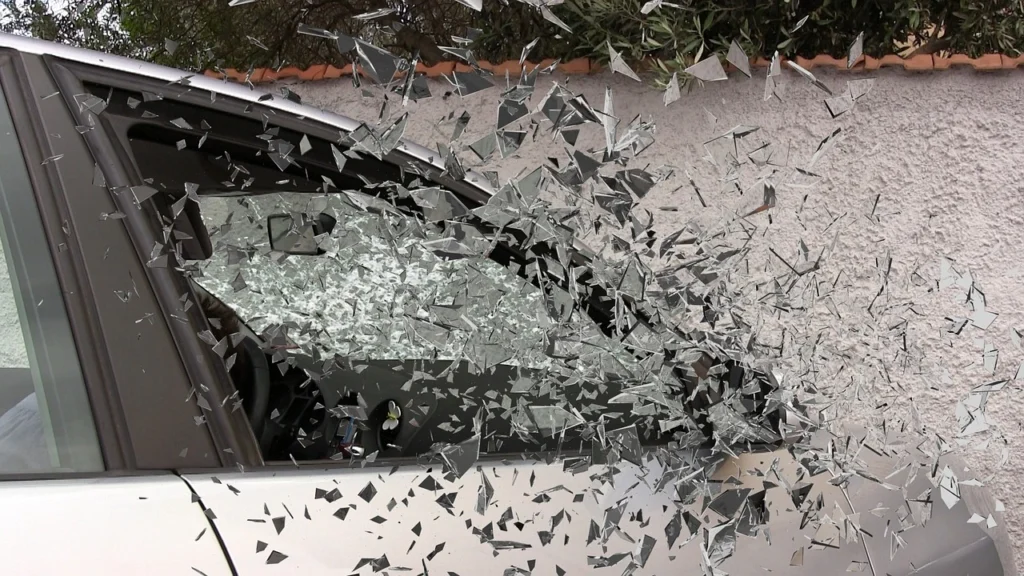How to Clean Broken Glass From Car Like a Pro
Accidents happen, and when they involve broken glass in your car, proper cleanup becomes crucial for safety and peace of mind. Whether it’s from a shattered window, a dropped object, or any other mishap, dealing with broken glass requires caution and a systematic approach. In this guide, we’ll walk you through the necessary steps for how to clean broken glass from car, ensuring thorough removal and minimizing the risk of injury or damage.
Steps For How To Clean Broken Glass From Car

Safety Precautions
- Safety goggles and gloves are essential for protecting your eyes and hands from potential injury caused by sharp glass fragments. Ensure that the goggles fit securely and provide adequate coverage, and choose gloves that are durable and puncture-resistant.
- Closed-toe shoes should be worn to protect your feet from stepping on small glass pieces that may be scattered on the ground. Sturdy shoes with thick soles are recommended to minimize the risk of injury.
- It’s important to keep pets and children away from the cleanup area to prevent them from accidentally coming into contact with sharp glass shards. Restrict access to the area until the cleanup process is complete and all glass debris has been safely removed.
Preparation
Before beginning the cleanup process, gather all necessary tools and materials to ensure efficiency and safety.
Dustpan and brush: Use a sturdy dustpan and brush set specifically designated for cleaning up glass debris. The brush should have stiff bristles to effectively sweep up small fragments.
Vacuum cleaner with hose attachment: Choose a vacuum cleaner equipped with a hose attachment to effectively suck up smaller glass pieces from hard-to-reach areas such as cracks and crevices.
Duct tape or masking tape: These tapes can be used to lift larger glass fragments safely and efficiently. Simply press the tape onto the surface where the glass is located, then peel it away gently to lift the glass without touching it directly.
Wet wipes or damp cloth: Use wet wipes or a damp cloth to wipe down surfaces and clean up any remaining glass residue. The moisture helps to trap small glass particles and prevent them from becoming airborne during the cleanup process.
Removing Large Glass Pieces
When dealing with larger glass fragments, one effective method is to use duct tape. Simply press a piece of duct tape firmly onto the surface where the glass is located, then peel it away gently. The adhesive on the tape will adhere to the glass, allowing you to lift it away safely without risking injury from sharp edges.
It’s crucial to advise against using bare hands to pick up glass. Even seemingly large pieces can have sharp edges that can cause cuts or puncture wounds. Always opt for safer methods like using tools or protective gear to handle glass debris.
Vacuuming Small Debris
Utilize a vacuum cleaner equipped with a hose attachment to effectively suck up smaller glass pieces. The suction power of the vacuum combined with the flexibility of the hose allows you to reach into crevices and corners where glass shards may be hiding.
Thoroughness is key when vacuuming to ensure all fragments are removed. Take your time and go over the entire area multiple times, paying special attention to areas where glass may have scattered or settled, such as under seats and in floor mats.
Wiping Surfaces
Dampen a cloth or use wet wipes to clean surfaces where glass may have left residue. The moisture helps to trap small glass particles and prevent them from becoming airborne, making cleanup safer and more effective.
Be sure to wipe down all areas where glass may have settled, including seats, floor mats, and any other surfaces within the car interior. Pay attention to seams and crevices where glass fragments may be lodged.
Final Inspection
Conduct a thorough inspection of the car interior to search for any remaining glass shards. Use a flashlight if necessary to illuminate dark areas and ensure no fragments are overlooked.
Run your hands over surfaces to detect any missed fragments that may not be visible to the naked eye. This tactile inspection can help to ensure that the interior is completely free of glass debris. If you want professional guidance then Reliable Auto Glass is best in business.
Disposal of Glass
Properly dispose of collected glass fragments by placing them in a sturdy container, such as a cardboard box or plastic bin. Avoid using containers that may easily break or puncture, and be sure to seal the container securely to prevent spillage.
Avoid mixing glass with regular household waste to prevent injury to sanitation workers and to facilitate recycling processes. If possible, separate glass debris for proper disposal at a recycling facility.
Conclusion
Effectively cleaning broken glass from a car requires a combination of safety precautions, thorough preparation, and meticulous attention to detail. Prioritizing safety by wearing protective gear such as goggles, gloves, and closed-toe shoes is paramount to prevent injuries from sharp glass fragments. Additionally, keeping pets and children away from the cleanup area is essential to minimizing the risk of accidents. Feel free to contact us for any type of service or query like how to clean broken glass from car.
FAQs
Q1: What Should I Do Immediately After Discovering Broken Glass In My Car?
A1: The first step is to ensure safety by putting on protective gear like gloves and goggles. Then, carefully assess the situation to determine the extent of the glass debris.
Q2: Can I Use A Regular Vacuum Cleaner To Clean Up Broken Glass From My Car?
A2: While a regular vacuum cleaner can be used, it’s essential to attach a hose to reach into tight spaces. Ensure the vacuum cleaner has sufficient suction power to effectively pick up small glass fragments.
Q3: Is It Safe To Use Bare Hands To Pick Up Larger Glass Pieces?
A3: No, it’s not safe. Always avoid using bare hands to pick up glass, as it can lead to cuts or puncture wounds. Instead, use tools like duct tape to lift larger fragments safely.
Q4: How Can I Prevent Glass Particles From Becoming Airborne During The Cleanup Process?
A4: Dampening a cloth or using wet wipes can help trap small glass particles and prevent them from scattering. Additionally, vacuuming thoroughly and using tape to lift larger pieces can minimize the risk of airborne particles.
Q5: What Should I Do If There Are Glass Shards Stuck In The Car’s Upholstery Or Crevices?
A5: Use a vacuum cleaner with a hose attachment to carefully extract glass particles from upholstery and hard-to-reach areas. Be thorough in your cleaning to ensure all fragments are removed.
Q6: Can I Dispose Of Broken Glass In My Regular Household Trash?
A6: It’s not recommended. Broken glass should be disposed of properly to prevent injuries to sanitation workers and facilitate recycling. Place glass fragments in a sturdy container and consider taking them to a recycling facility if possible.

